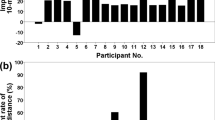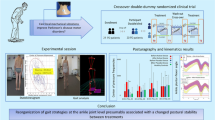Abstract
The aim of this pilot study is to test the feasibility and effectiveness of a wearable proprioceptive stabilizer that emits focal mechanical vibrations in patients affected by hereditary cerebellar ataxias. Eleven adult patients with a confirmed genetic diagnosis of autosomal dominant spinocerebellar ataxia or Friedreich’s ataxia were asked to wear an active device for 3 weeks. Assessments were performed at baseline, after the device use (T1), and 3 weeks after (T2). SARA, 9-HPT, PATA, 6MWT, and spatial and temporal gait parameters, measured with a BTS-G-Walk inertial sensor, were used as study endpoints. As expected, no adverse effects were reported. Statistically significant improvements in SARA, 9HPT dominant hand, PATA test, 6MWT, cadence, length cycle, support right/cycle, support left/cycle, flight right/cycle, flight left/cycle, double support right/cycle, double support left/cycle, single support right/cycle, and single support left/cycle were observed between T0 and T1. All parameters improved at T1 did not show statistically significant differences a T2, with the exception of length of cycle. This small open-labeled study shows preliminary evidence that focal mechanical vibration exerted by a wearable proprioceptive stabilizer might improve limb and gait ataxia in patients affected by hereditary cerebellar ataxias.

Similar content being viewed by others
References
Jayadev S, Bird TD (2013) Hereditary ataxias: overview. Genet Med 15:673–683
Schniepp R, Wuehr M, Schlick C, Huth S, Pradhan C, Dieterich M et al (2014) Increased gait variability is associated with the history of falls in patients with cerebellar ataxia. J Neurol 261:213–223
Schieppati M, Crenna P (1984) From activity to rest: gating of excitatory autogenetic afferences from the relaxing muscle in man. Exp Brain Res 56:448–457
Desmedt JE, Godaux E (1978) Mechanism of the vibration paradox: excitatory and inhibitory effects of tendon vibration on single soleus muscle motor units in man. J Physiol 285:197–207
Burke D, Hagbarth KE, Lofstedt L, Wallin BG (1976) The responses of human muscle spindle endings to vibration during isometric contraction. J Physiol 261:695–711
Eklund G (1972) General features of vibration-induced effects on balance. Ups J Med Sci 77:112–124
Courtine G, De Nunzio AM, Schmid M, Beretta MV, Schieppati M (2007) Stance- and locomotion-dependent processing of vibration-induced proprioceptive inflow from multiple muscles in humans. J Neurophysiol 97:772–779
Smiley-Oyen AL, Cheng HY, Latt LD, Redfern MS (2002) Adaptation of vibration-induced postural sway in individuals with Parkinson’s disease. Gait Posture 16:188–197
Nardone A, Schieppati M (2005) Reflex contribution of spindle group Ia and II afferent input to leg muscle spasticity as revealed by tendon vibration in hemiparesis. Clin Neurophysiol 116:1370–1381
Bove M, Nardone A, Schieppati M (2003) Effects of leg muscle tendon vibration on group Ia and group II reflex responses to stance perturbation in humans. J Physiol 550:617–630
Equistasi website. http://www.equistasi.com/en/. Accessed 13 Dec 2013
Necking LE, Lundstrom R, Dahlin LB, Lundborg G, Thornell LE et al (1996) Tissue displacement is a causative factor in vibration-induced muscle injury. J Hand Surg Br 21:753–757
Alfonsi E, Paone P, Tassorelli C et al (2015) Acute effects of high-frequency microfocal vibratory stimulation on the H reflex of the soleus muscle. A double-blind study in healthy subjects. Funct Neurol 30(4):269–274
Volpe D, Giantin MG, Fasano A (2014) A wearable proprioceptive stabilizer (Equistasi®) for rehabilitation of postural instability in Parkinson’s disease: a Phase II Randomized Double-Blind, Double-Dummy, Controlled Study. Quinn TJ, ed. PLoS One 9(11):e112065
Spina E, Carotenuto A, Aceto MG, Cerillo I, Silvestre F, Arace F, Paone P, Orefice G, Iodice R (2016) The effects of mechanical focal vibration on walking impairment in multiple sclerosis patients: a randomized, double-blinded vs placebo study. Restor Neurol Neurosci:1–8 (preprint)
Pazzaglia C, Camerota F, Germanotta M, Di Sipio E, Celletti C, Padua L (2016) Efficacy of focal mechanic vibration treatment on balance in Charcot-Marie-Tooth 1A disease: a pilot study. J Neurol 263(7):1434–1441
ATS statement: guidelines for the six-minute walk test, (2002) ATS Committee on Proficiency Standards for Clinical Pulmonary Function Laboratories. Am J Respir Crit Care Med 166(1):111–117
Weyer A, Abele M, Schmitz-Hubsch T, Schoch B, Frings M, Timmann D (2007) Reliability and validity of the scale for the assessment and rating of ataxia: a study in 64 Ataxia patients. Mov Disord 22:1633–1637
De Nunzio AM, Nardone A, Picco D, Nilsson J, Schieppati M (2008) Alternate trains of postural muscle vibration promote cyclic body displacement in standing parkinsonian patients. Mov Disord 23:2186–2193
Thompson M, Medley A (2007) Forward and lateral sitting functional reach in younger, middle-aged, and older adults. J Geriatr Phys Ther 30:43–48
Schmitz-Hübsch T, Fimmers R, Rakowicz M, Rola R, Zdzienicka E, Fancellu R et al (2010) Responsiveness of different rating instruments in spinocerebellar ataxia patients. Neurology 74:678–684
Schwesig R, Leuchte S, Fischer D, Ullmann R, Kluttig A (2011) Inertial sensor based reference gait data for healthy subjects. Gait Posture 33:673–678
Roll JP, Vedel JP (1982) Kinaesthetic role of muscle afferents in man, studied by tendon vibration and microneurography. Exp Brain Res 47:177–190
Marsden CD, Meadows JC, Hodgson HJ (1969) Observations on the reflex response to muscle vibration in man and its voluntary control. Brain 92:829–846
Kording KP, Wolpert DM (2006) Bayesian decision theory in sensorimotor control. Trends Cogn Sci 10:319–326
Lackner JR, Levine MS (1979) Changes in apparent body orientation and sensory localization induced by vibration of postural muscles: vibratory myesthetic illusions. Aviat Space Environ Med 50:346–354
Author information
Authors and Affiliations
Corresponding author
Ethics declarations
Conflict of interest
On behalf of all authors, the corresponding author states that there is no conflict of interest.
Additional information
L. Leonardi and M. G. Aceto contributed equally to the manuscript conceiving and writing.
Rights and permissions
About this article
Cite this article
Leonardi, L., Aceto, M.G., Marcotulli, C. et al. A wearable proprioceptive stabilizer for rehabilitation of limb and gait ataxia in hereditary cerebellar ataxias: a pilot open-labeled study. Neurol Sci 38, 459–463 (2017). https://doi.org/10.1007/s10072-016-2800-x
Received:
Accepted:
Published:
Issue Date:
DOI: https://doi.org/10.1007/s10072-016-2800-x




